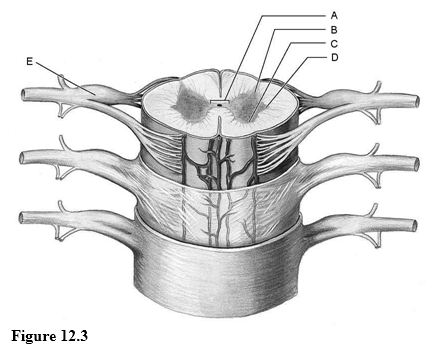Which of the following statements concerning cerebrospinal fluid is incorrect? Cerebrospinal fluid
a. is formed by the choroid plexuses and is reabsorbed across the arachnoid villi into the blood within the dural sinuses.
b. serves as a shock-absorbing fluid to cushion the brain against jarring movements.
c. comes into direct contact with the neuronal and glial cells.
d. fills the subarachnoid space.
e. influences the composition of the brain interstitial fluid more than the blood does.
C
You might also like to view...
Using Figure 12.3, match the following:

1) Site of efferent soma.
2) Site of axons and afferent neurons.
3) Site of sensory soma.
4) Gray commissure.
5) Horn usually containing interneurons.
6) Site containing central canal.
7) Multipolar neurons are common here.
Thyroid hormone secretion decreases with age. Treatment with thyroid-releasing hormone is less effective in younger patients, while treatment with thyroid hormone is more effective in younger patients. What name is given to the condition of decreased thyroid hormone secretion? What related hormones are likely to decrease as well? Propose an explanation for the loss of responsiveness to the
releasing hormone. Propose an explanation for the increased responsiveness to treatment with thyroid hormone (consider both how hormones affect target cells and how hormone action is halted). What will be an ideal response?
The chemoreceptor reflexes help maintain homeostasis
A. under normal conditions. B. when epinephrine levels increase. C. when H+ concentrations decrease. D. when stimulated by changes in blood osmotic pressure. E. when CO2 levels increase.
The Bohr effect refers to the
A. mechanism involved in diffusion of nitrogen into the blood. B. physical laws governing the solubility of gases in fluids. C. effect of pH on the oxygen-hemoglobin dissociation curve. D. chemical equilibrium between carbonic acid and bicarbonate in the blood. E. effect of temperature on the oxygen-hemoglobin dissociation curve.